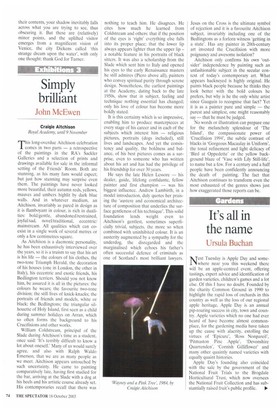Simply brilliant
John McEwen
Crahlie Aitchison Royal Academy, until 9 November phis long-overdue Aitchison celebration comes in two parts — a retrospective of the paintings in the RA's Sackler Galleries and a selection of prints and drawings available for sale in the informal setting of the Friends' Room. Both are stunning, as his many fans would expect; but just how stunning may surprise even them. The paintings have never looked more beautiful, their autumn reds, yellows, mauves and umbers highlit by dark blue walls. And in whatever medium, an Aitchison, invariably as pared in design as it is flamboyant in colour, is rich in dualities: bold/gentle, abandoned/restrained, joyful/sad, novel/traditional, eccentric/ mainstream. All qualities which can coexist in a single work of several metres or only a few centimetres square.
As Aitchison is a daemonic personality, he has been exhaustively interviewed over the years, so it is a truism to say that his art is his life — the colours of his clothes, the two-tone Triumph Herald, the decoration of his houses (one in London, the other in Italy), his eccentric and exotic friends, his Bedlington terriers. Should you not know him, be assured it is all in the pictures: the colours he wears; the favourite two-tone division; the still lives of knick-knacks; the portraits of friends and models, white or black; the Bedlingtons; the triangular silhouette of Holy Island, first seen as a child during summer holidays on Arran, which so often forms the background to his Crucifixions and other works.
William Coldstream, principal of the Slade during Aitchison's time as a student, once said: 'It's terribly difficult to know a lot about oneself.' Many of us would surely agree, and also with Ralph Waldo Emerson, that we are as many people as we meet. Aitchison appears untouched by such uncertainty. He came to painting comparatively late, having first studied for the bar, arriving at the Slade with a dog at his heels and his artistic course already set. His contemporaries recall that there was nothing to teach him. He disagrees. He cites how much he learned from Coldstream and others: that if the position of the eyes is 'right' everything else falls into its proper place; that the lower lip always appears lighter than the upper lip – a notable feature in his portraits of black sitters. It was also a scholarship from the Slade which sent him to Italy and opened his eyes to the early Renaissance masters he still admires (Piero above all), painters who convey spiritual purity through serene design. Nonetheless, the earliest paintings at the Academy, dating back to the late 1950s, show that in subject, feeling and technique nothing essential has changed; only his love of colour has become more boldly stated.
It is this certainty which is so impressive, enabling him to produce masterpieces at every stage of his career and in each of the subjects which interest him — religious pictures, portraits (dogs included), still lives and landscapes. And yet the consistency and quality, the boldness and balance, of his best pictures comes as a surprise, even to someone who has written about his art and has had the privilege of his friendship for over 30 years.
He says the late Helen Lessore — his dealer, guide, lifelong confidante, fellow painter and first champion — was his biggest influence. Andrew Lambirth, in a model introduction, duly quotes her praising the 'austere and economical architecture of composition that underlies the surface gentleness of his technique'. This solid foundation lends weight even to Aitchison's gentlest, sometimes superficially trivial, subjects, the more so when combined with uninhibited colour. It is an austerity augmented by a sympathy for the underdog, the disregarded and the marginalised which echoes his father's often successful defence of criminals as one of Scotland's most brilliant lawyers. Jesus on the Cross is the ultimate symbol of rejection and it is a favourite Aitchison subject, invariably including one of the Bedlingtons as a forlorn witness 'getting in a state'. Has any painter in 20th-century art invested the Crucifixion with more poignancy and awesome isolation?
Aitchison only confirms his own 'outsider' independence by painting such an unfashionable subject in the secular context of today's contemporary art. What appears hackneyed is highly original. He paints black people because he thinks they look better with the bold colours he prefers, but why is he the only white artist since Gauguin to recognise that fact? Yet it is as a painter pure and simple — the purest and simplest, one might reasonably say — that he must be judged.
No words or illustration can prepare one for the melancholy splendour of The Island', the compassionate power of 'Crucifixion 1994', the subtle contrast of blacks in 'Gorgeous Macaulay in Uniform', the tonal refinement and light delicacy of 'Bird at Oppedette' or the yellow background blaze of 'Vase with Lily Still-life', to name but a few. For a century and a half people have been confidently announcing the death of painting. The fact that Aitchison continues to transform even the most exhausted of the genres shows just how exaggerated those reports can be.


































































































 Previous page
Previous page